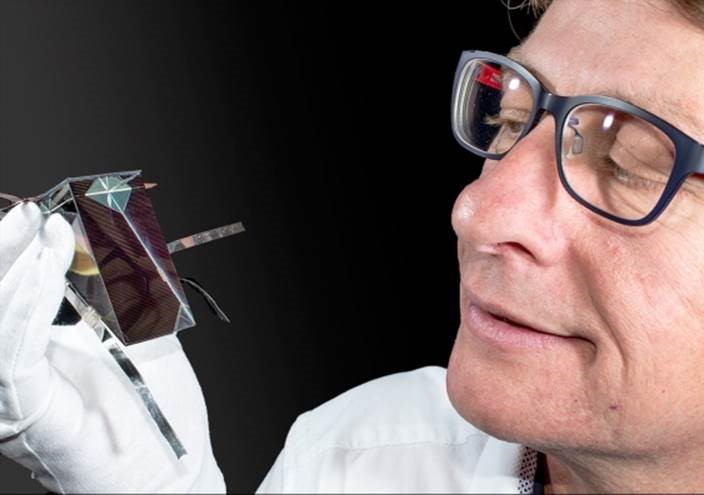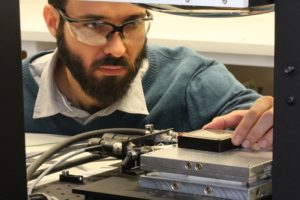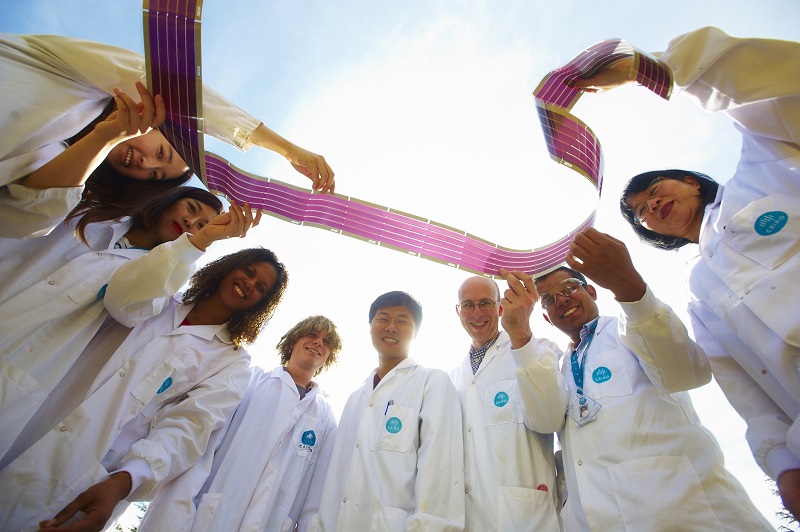A world-first was achieved this week at the University of New South Wales who found a way to improve the light-gathering ability of solar cells.

Who would’ve thought a prism could be so energy efficient? Dr Keevers showcases his research Photo credit: Rob Largent/UNSW
We love a world-first here at CSIRO. Every day, our scientists are working to crack the next best thing to benefit the nation. Back in 2014 in the energy domain, we were the first to create super critical steam at the hottest temperature ever outside of fossil fuel sources. Instead, we used concentrating solar thermal technology (a field of heliostat mirrors that concentrate heat from the sun). That’s pretty darn impressive as it shines the light on, or in this case, steams up the conversation about the critical role the sun plays for a low emissions energy future in Australia.
Another world-first was achieved this week by our friends at the University of New South Wales, in particular the researchers’ Professor Martin Green and Dr Mark Keevers, who have found a way to improve the light-gathering ability of solar cells.
Cutting shapes in the solar stakes
We’re not sure what sort of shapes the researchers can cut on the dancefloor, but they sure know how to use shapes for the advantage of solar efficiency, in this case, a prism. But how can a prism potentially change the future of solar efficiency we hear you ask?
Our own Dr Chris Fell of the CSIRO Photovoltaic Performance Laboratory explains.
“The UNSW device captures light from all directions onto two separate cells, while only taking up the space of a single cell. The cells and the prism work together to extract the maximum energy from sunlight, using a special reflective layer and multi‑junction technology to split the light into four separate colour bands,” he says.
Easy! Well, not quite.
Rooftops are where it’s at
It may be about 10 years until we may see this technology deployed on rooftops across Australia due to the manufacturing costs. Dr Keevers said, “This encouraging result shows that there are still advances to come in photovoltaics research to make solar cells even more efficient. Extracting more energy from every beam of sunlight is critical to reducing the cost of electricity generated by solar cells as it lowers the investment needed, and delivering payback faster.”

Those panels on your roof would’ve started out in a lab, in the form of a solar cell.
Professor Green added, “What’s remarkable is that this level of efficiency had not been expected for many years. So things are moving faster in solar cell efficiency than many experts expected, and that’s good news for solar energy. But we must maintain the pace of photovoltaic research in Australia to ensure that we not only build on such tremendous results, but continue to bring benefits back to Australia.”
Advance Australia solar
Research Group Leader for Solar Energy Systems, Dr Greg Wilson, commenting on the record announcement said, “The UNSW result is a fine example of how Australian R&D is breaking the mould and shaping the future of solar on the international stage. At CSIRO we carry out extensive research across the entire technology chain for solar including new materials discovery, device fabrication and optimisation, materials characterisation and cell performance determination, energy yield and system design.”’
“The advances made by UNSW build on a long history of breakthroughs in solar photovoltaics led by Professor Green that have helped grow a world-wide industry. Research investment in solar is not only an investment in our future, it’s an investment in innovation for Australia” added Greg.

Our researchers aren’t holding a purple snake; it’s printable solar cells.
What’s next for solar cells?
As the leading research agency in Australia (we like saying that, it makes us feel all warm and fuzzy), we have a whole energy business unit dedicated to renewable energy research including two solar research fields to test all the latest whizz-bang developments in large-scale solar technology. Our approach to renewable energy incorporates understanding of the impacts of solar on the electrical grid to ensure we have access to stable electricity, and how to use it in the most efficient way.
Find out more about our work in renewables and energy on our website.


9th July 2016 at 10:20 am
Prism solar cells were suggested in 1975 to increase solar capture and re-aradiation by re -reflection back onto local areas,only half taken up by the swiss who used that half principal to encrease performance for their electric car challenge.
By splitting the beam further into its mirriod array ,and using its compliment (Radio-Absorbtion) additional proton movement can be acheived. This is listed by CSIRO in their ,
(Atomic Absorbtion Spectrometer )Chart .
When you acheive this, successfully I have forward projects way beyond the above concept to keep you entertained.
My qualifications UNSW post graduate, Video Communications,
IN (AV) designed your first automated recording and play back Studio, Also designed your standard recording Studio,
And undersized projection theatre for all present and future formats,
HEAD of CHAIR all AV technicians NSW and personel consultant to Chancellor on special projects.
If you what a laugh, I have no official degrees!
Regards Stephen Fitton.
8th July 2016 at 2:26 pm
I, like many commenters here are seriously underwhelmed by the quality of science journalism being offered on this site. Who do you think reads this stuff, science illiterate baboons? By far and away the most useful part of this page was the link to Cosmos, kindly provided by Sergeant Awesome. Are you shy, or just unsure of what your readership wants. Even if you provided links that actually told you more, not less, about the subject, it would be a help.
7th September 2016 at 10:21 pm
I had much the same thought. PR fluff for morons was what sprung to mind. A sad reflection of an organisation that likes to continually blow its own trumpet about how smart it is.
17th June 2016 at 3:15 pm
I agree, this article is fluff. Who, for example. made that printed ribbon of cells? If it is significant, what is its performance? If not why show it?
27th May 2016 at 3:41 pm
What is the efficiency gains compared to traditional solar cells? Are we talking about a few percents or more?
Thanks for sharing more about this great news!
21st May 2016 at 9:43 am
How efficient are they? Give us some stats.
23rd May 2016 at 5:23 pm
agreed, what a pointless article. Where is the science?
27th May 2016 at 4:43 pm
34.5% according to Cosmos Magazine
https://cosmosmagazine.com/technology/australian-scientists-smash-solar-cell-efficiency-record
Previous record was 2%
27th May 2016 at 4:44 pm
Edit function would be nice.
Previous record was 24% not 2%. Typo error entirely down to me.